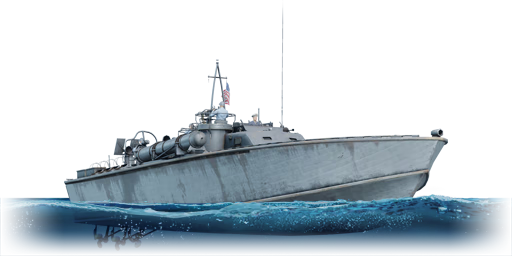



The Elco 80ft PT-103 was the lead boat of 93 PT-103 sub-class of Elco 80ft PT boats. The PT-103 sub-class was the most produced variant of the American PT boats during World War II, and served as a "standard" model for subsequent designs. As for PT-103 itself, it was laid down at the Elco shipyard in Bayonne, New Jersey on 24 January 1942 and launched on 16 May. After being assigned to the 5th Torpedo Boat Flotilla at the Panama Canal, the PT-103 and the 5th Flotilla were transferred to the Solomon Islands in 1943 and took part in the Solomon Islands campaign. After the 5th Flotilla was disbanded in 1944, PT-103 was reassigned to the 18th Flotilla and saw combat in the southwest Pacific theatre. However, after the war ended, the US Navy chose to dispose of the remaining PT boats rather than returning them home due to cost issues, and as such the PT-103 was scuttled on 4 November 1945 in the Philippines.
Introduced in Update 1.77 "Advancing Storm", the PT-103 is the first of the standard 80ft Elco PT boats, and as such it features typical characteristics of the type; two pairs of Browning MGs being placed in an offset position to provide better coverage for both guns compared to its predecessors, the PT-20 and PT-95, and a decently powerful autocannon at the stern, in this case a single Oerlikon autocannon. However, it is still largely similar to its predecessor in terms of weaknesses, namely the fragile construction and extremely vulnerable sides, so care must be taken not to expose them to the enemy.
| Belt | Belt filling | Armor penetration (mm) at a distance: | |||||
|---|---|---|---|---|---|---|---|
| 10 m | 100 m | 500 m | 1000 m | 1500 m | 2000 m | ||
| API-T/AP/I/AP | 29 | 27 | 20 | 13 | 9 | 6 | |
| API-T/AP/AP/AP | 29 | 27 | 20 | 13 | 9 | 6 | |
| API-T/API-T/API-T/I | 28 | 26 | 20 | 15 | 13 | 11 | |
| Belt | Belt filling | Armor penetration (mm) at a distance: | |||||
|---|---|---|---|---|---|---|---|
| 10 m | 100 m | 500 m | 1000 m | 1500 m | 2000 m | ||
| HEF-T/HEF-I/AP-T | 34 | 32 | 26 | 21 | 18 | 16 | |
| AP-T/AP-T/AP-T/HEF-I | 34 | 32 | 26 | 21 | 18 | 16 | |
| HEF-T/HEF-I/AP-T/HEF-I | 34 | 32 | 26 | 21 | 18 | 16 | |
8 × Mk.6 depth charge
